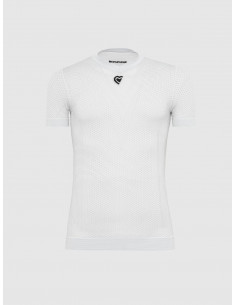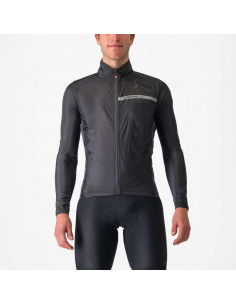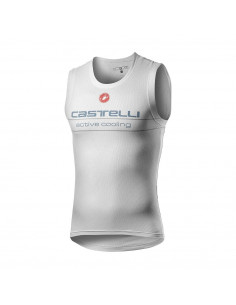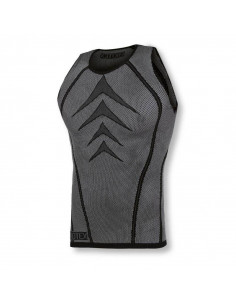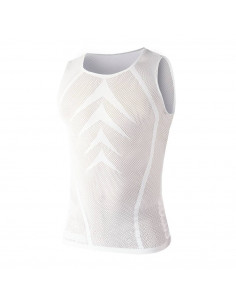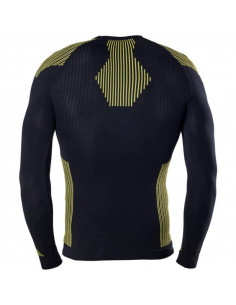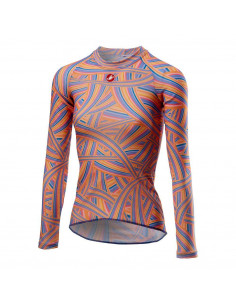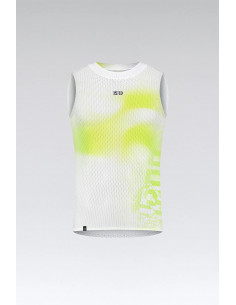Thermal Cycling Clothing
Thermal cycling clothing is very efficient for the sports practice of cycling. Thermal cycling clothing are those cycling clothing garments, which are used as the first layer close to the body, since thermal cycling clothing is made of specific and technical fabrics that protect us from the cold when we use the bicycle. Within the range of thermal cycling clothing we can differentiate different cycling clothing depending on the type of use we want to give it, for example within thermal cycling clothing one of the most important garments that we must pay more attention to is the shirt thermal cycling, which is the first layer that we wear attached to the chest and is the one that protects us from the cold on the chest, prevents excessive sweating and allows us to stay dry and warm at the same time. Another of the most important garments in thermal cycling clothing are thermal cycling socks that protect the feet from the cold and last but not least within the range of thermal cycling clothing are thermal cycling gloves, which protect the hands. of the wind, the cold and the numbness produced by the use of the bicycle in the cold.
Thermal cycling shirt
The thermal cycling shirt is one of the thermal cycling clothing garments to which we must give the most importance, since they are the shield of the chest against the cold and wind. When choosing a thermal cycling shirt it is important to know how to choose both the size and the fabrics with which the thermal cycling shirt is made. The first thing we must choose is the size of the thermal cycling shirt that suits us, taking into account that they are garments that have to fit well, avoiding wrinkles, to perfectly perform their function as a thermal cycling shirt. The fabric of the thermal cycling shirt must be thermal but breathable, that is, it allows us to keep warm and not get cold while evaporating sweat and preventing the thermal cycling shirt from getting soaked.
Men's Thermal Cycling Shirt
The men's thermal cycling shirt is a piece of cycling clothing that goes inside the chest and is the first layer in contact with the cyclist's body, therefore the men's thermal cycling shirt must be made of breathable fabrics, but at the same time thermal ones that allow good cooling of the body along with insulation from the cold and the wind. The men's thermal cycling shirt is also used unisex, since there is not much difference in this type of cycling clothing between the men's thermal cycling shirt and the women's thermal cycling shirt.
women's thermal cycling jersey
The women's thermal cycling shirt has a specific pattern that adapts to the female body and fits better to the body. The women's thermal cycling shirt has the same quality and types of complaints as a conventional cycling thermal shirt, since they are the same type of garment but with different sizes to better fit women's cycling. You can buy women's thermal cycling t-shirt from brands such as Casteli, ASSOS or Kavant with high-performance women's thermal cycling t-shirt models.
THERMAL T-SHIRTS
Cycling is a tough, demanding sport that takes place outdoors, so it is subject to the vagaries of the weather. Rain, cool or ice, if you're going to pedal you need to have the right equipment.
An extremely useful resource is to incorporate high-quality thermal cycling shirts into your kit, so choosing the right thermal shirt for winter is a guarantee of success and optimal performance. The choice of this type of clothing that we are going to use is decisive and will be of great help to us, since if you are cold or hot your performance will be reduced, and this is something that we can avoid with appropriate clothing.
Any cyclist is clear that the cold is a dangerous enemy, because the environmental thermal sensation will be increased by the speed of the wind when moving. That is why within cycling clothing, thermal underwear shirts have become one of the garments that provide greater comfort and lightness to the cyclist. Its ability to offer thermal insulation means that the person who rides the bike does not have to wear uncomfortable and heavy layers of clothing that hinder their performance in sports. Current technological advances increasingly provide impeccable elasticity to this type of garment, thanks to which they mold to the user's figure as if it were a second skin. So much so that, when it is adjusted correctly, it can go unnoticed as such, which does not mean that the same happens with its benefits.
Thermal undershirts are very efficient garments, especially for cycling, since they respond to three fundamental functions and are of great importance to take into account within this type of sport, ours. That is to say, they are fundamental to us since;
• They prevent the loss of natural heat generated by our body during the practice of physical activity.
• They favor and facilitate the perspiration of our skin.
• And lastly, they keep the body dry after physical exercise for much longer.
Thermal jerseys are garments that must fit perfectly to the cyclist's body but without being too tight to allow the cyclist to move easily. Among the different models of this type of t-shirt are those that have been designed under ergonomic lines, which are more tailored, and those that simply look like a normal t-shirt. Even so, all of them have in common the purpose of maintaining correct ventilation and favoring the regulation of body temperature. Thermal cycling shirts are a highly recommended basic since they protect from the cold, conserve internal heat and control humidity thanks to their breathability.
In ancient times, it is worth remembering or making a brief reference to the fact that cyclists took the newspapers from the public to place them under their jerseys, in the chest area, and thus be able to protect their chest from the cold or the wind. Hence the importance that some models of today also incorporate additional technology against the wind, and the best current thermal shirts for winter, shield and protect this particular chest area from inclement weather. Thermal shirts are therefore part of the key clothing for the practice of cycling, according to their design, they will help you stay dry for longer, or protected, by allowing breathability or by incorporating increasingly sophisticated techniques.
How to choose a thermal inner shirt for cycling?
Two of the most important factors that we must take into account when buying this cycling garment are the discipline for which we are looking for our equipment and the sports practice that we are going to do with it.
In this case, we must look for technical clothing that fits very well if we train and compete in road cycling or Mtb, and yet we will opt for a slightly looser garment if we are starting in this world, or we dedicate ourselves more to pedaling. with our group, also seeking the maximum degree of comfort in all situations. The specific fit will depend, as with the rest of the garments, in addition to the type of cycling practice you do, on your personal taste. There are some very tight or more technical ones that reduce friction, improve breathability and allow greater speed on the bicycle, that is, a more aerodynamic performance, or on the contrary you can also find some others that are a little looser if it is your preference. or you do not give it such a professional use. In general, mountain bikers, for example, tend to wear somewhat wider synthetic garments.
The undershirts constitute the first layer that the cyclist puts on, so they will be the ones that will be in direct contact with the skin. They are suitable for the whole year and have the function of absorbing all the sweat. Many do not pay enough attention to the undershirt, but to be completely sheltered and protected from the cold you must start with it, the first layer. Some of these garments have thermo-adjustable fibers, allowing sweat to be evacuated towards the other outer layers of clothing. Normally, these garments are made of fabrics such as polyester, nylon and other materials such as polypropylene that provide the user with maximum comfort and a very pleasant dry sensation, since they expel moisture to the outside immediately. To avoid bad odors, antimicrobial characteristics are also added.
During the winter it provides an extra layer to protect you from the cold, so they are also used as a thermal barrier. And during the summer it offers you greater breathability. These garments can be found in many models, sleeveless or sleeved, with windproof coating and with different types of collars. Depending on what we are willing to spend, we can find some more basic ones that are similar to a shirt for the summer with the thermal insert, but that do not have waterproofing, and that are not very useful if the weather is changeable and suddenly rain appears. Or on the contrary, you can find others with more advanced features such as breathability, waterproofing, roubaix linings, or with higher quality fabrics.
Characteristics or basic advice to choose the most suitable thermal shirt
There is a wide variety of specialized thermal shirts on the cycling market; There are many types, characteristics, designs, brands and qualities and, of course, with very varied prices, as is normally the case, depending above all on what we are looking for. An essential starting point is to be clear about your needs, your preferences and your expectations, but above all how much our budget is. Well, although there are excellent thermal t-shirts at fairly cheap prices, you cannot expect to have the same benefits that a 20-euro t-shirt offers us as another, for more than 100. We must not only take into account how much we will be willing to spend to stop satisfy our needs, but we must know its characteristics in depth to know how to choose the most suitable thermal shirt according to our knowledge. For this, we are going to stop to analyze in depth a series of characteristics or details that we cannot ignore and that are not always analyzed with sufficient detail. Not all thermal shirts are the same even if they seem identical to us, so according to this same order of priority that we are going to present to you below, we must stop to analyze;
First of all, we must take a good look at the material in which the garment is made. Cotton is not the same as wool, silk or polyester. This is fundamental and we must always look at the label, which will be where we must be informed of the materials and the percentages of their composition in which it is manufactured. Synthetic materials are the most used. They guarantee heat retention, dry quickly and efficiently, and are breathable. Another of the materials used is cotton, although they are not usually one of the most recommended since it gets too soaked and becomes heavy, but it also manages to provide thermal characteristics. Silk is also used for high-quality t-shirts, they absorb moisture and are very soft, providing comfort.
Secondly, we must choose insulating and breathable fibers, which makes the shirt thermal and thus insulates it from cold and heat. In other words, your body will generate heat that the shirt will prevent from being lost to the outside, therefore, the better insulator the material is, the warmer you will be. In this aspect, the fibers that have the highest thermal quality or work in the best way: they are wool, silk or polyester and specifically, in that order.
Wool and silk are materials that generate microbubbles of air inside the fiber, which makes it a great insulator and absorbs moisture from your body. In addition to being spongy surfaces, they form a layer of air between the skin and the garment that adds insulation. If we add to this that they are natural fibers without chemical treatments (in the case of organic wool and silk), we can say that they are the best thermal materials to wear attached to our body. Regarding organic cotton, we will say that it is a material that absorbs moisture well and has a very pleasant touch, but it is not the best insulator, so we will notice a sensation of cold when we sweat. They can sell it to you as thermal because it is another layer of clothing, but we cannot say that cotton is a material used as a winter thermal shirt.
In conclusion, when recommending an insulating and breathable material par excellence, we could point to merino wool as the best example, since it is soft, comfortable and allows us to maintain body heat at all times. It also does not cause bad odors and absorbs moisture very well.
Lastly and thirdly, we must look for organic fibers without added toxins. And what does this mean, you will ask, right? Our body has a toxic backpack that we fill until we can't take it anymore, at which point we can generate what are now called environmental diseases (atopic skin, electrosensitivity, etc.). Therefore, if we avoid as much as possible that toxic substances come into direct contact with our body, we will help that we do not have to generate defenses against these toxins. In addition, if we take into account that we wear thermal clothing close to our body, it is much more important that we take into account avoiding this type of chemical substances.
We have already seen that depending on the type of material used in the making of this garment, some properties can be highlighted more than others, but the final performance will also depend on another characteristic to be taken into account, the thickness or grammage of the fabric, that is to say , the weight in grams for each square meter of fabric. The materials used will adapt according to the temperature to which we are accustomed, the thicker the fabric, the greater the ability to give heat. In a very general classification, the weights found in the first layers can be grouped into three different types or thickness scales:
• From 100 to 150 g/m 2: used for thin and light t-shirts, suitable for active use or when the weather is not too cold.
• From 150 to 200 g/m 2: this thickness range is usually the most used for the first layers, or what is the same, they allow for the most versatile use. In this case, they are suitable for climates with a consequently more intermediate temperature.
• From 200 to 260 g/m 2: this type of thickness, on the other hand, is used for thick first layers that are going to be used in cold environments or in somewhat more static situations.
It is also usually a common and very successful resource to combine different weights in the same garment, obviously using the lightest in the areas of greatest perspiration, such as in the armpits or on the back. In the most versatile technical garments that can be used either as a first or even as a second layer, one of the current trends is to include a breathable insulation front panel to optimize protection against the cold, wind or light rain, as we saw at the beginning.
Once we have taken into account these detailed characteristics with respect to the fabric or material, and the thickness used in its manufacture, we will take note of other external factors that we must not lose sight of, and that will ultimately help us to make the best possible option before all the multitude of models with which we can find. These last recommendations, although they seem obvious to us, can definitely help us choose the one that best suits us in a particular way;
• The type of climate in which we normally develop will make us decide more on one type of garment in particular than another, since it is not the same to live, for example, in the north than in the south of our country. So while some should lean more towards shirts with less thermal load and more load in terms of perspiration, others should choose just the opposite. Similarly, some will also choose short sleeves and even sleeveless, instead of long sleeves. We want to avoid excess sweating, we do not want colds or dehydration.
• The personal perception of cold, not all of us perceive or feel cold or heat in the same way, each of us belongs to our father and mother and when one is cold, there is another who is sweating profusely. For those cold people who, even though it's August, still don't lose sight of long sleeves, it's best to choose a thick thermal with high calorific value. In the same way that someone who does not stop sweating even when it is minus three degrees, a short-sleeved shirt will be more than enough at least to help him perspire or isolate this sweat and in the same way it can be more comfortable.
• As we have already made reference to before and to finish, the type of activity or modality that we practice the most will be fundamental in our choice, since it is not the same to go out on a mountain bike through the mountain next to the house protected by the forest that go out on the road. The sensation of speed marks the need for more shelter. And in the same way, the most demanding outings will cause more sweating and the need to go less warm, but above all that the chosen clothing is capable of perspiring at full speed. If we practice both modalities, the most normal thing is that we end up allocating a thermal shirt for depending on what utility.
.
In short, whatever the use that we have to give it or what model we finally choose, what we do believe has become clear is that we will not be able to practice this type of sport without being accompanied by a good quality thermal base layer. The benefits that it brings us, as we have seen, are much greater, for example, than the expense that it causes us, therefore, if you still do not have it clear, here we leave you to finish the three fundamental advantages that the use of this type of clothing brings to the athlete.
Benefits of thermal shirts
- The elasticity and comfort of this type of t-shirt, which conforms to the body with total softness and naturalness as if we weren't wearing anything, provides the cyclist with warmth or a feeling of well-being, without generating any type of discomfort on the saddle, which is the greatest of the advantages for the user, the comfort that it offers on our bicycle.
- The warmth provided by this type of clothing because it retains and maintains body temperature from the first moment is another of its main virtues. In the same way, they effectively protect us against the cold or the wind, so their use is completely versatile.
- The retention of sweat is another of the most uncomfortable sensations when we pedal on our bicycle, which we could avoid with the use of this type of clothing. This is because the modern and advanced fabrics with which these types of garments are made especially enhance perspiration and wick away sweat quickly. In addition, in our case, they are able to control humidity very efficiently. All of these are benefits to be taken into account as they provide or contribute to improving the well-being and concentration of the cyclist.
As one of the pros from before said, the real ones, if after all this that we have discussed, you are still cold on the bike, remember...
It's not that the weather is bad, it's that you're not well equipped!!!!
And he is more right than a saint: well equipped and prepared, you can enjoy the bike in any type of weather.



